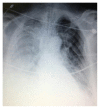The PIEPEAR Workflow: A Critical Care Ultrasound Based 7-Step Approach as a Standard Procedure to Manage Patients with Acute Cardiorespiratory Compromise, with Two Example Cases Presented
- PMID: 29992144
- PMCID: PMC6016228
- DOI: 10.1155/2018/4687346
The PIEPEAR Workflow: A Critical Care Ultrasound Based 7-Step Approach as a Standard Procedure to Manage Patients with Acute Cardiorespiratory Compromise, with Two Example Cases Presented
Abstract
Critical care ultrasound (CCUS) has been widely used as a useful tool to assist clinical judgement. The utilization should be integrated into clinical scenario and interact with other tests. No publication has reported this. We present a CCUS based "7-step approach" workflow-the PIEPEAR Workflow-which we had summarized and integrated our experience in CCUS and clinical practice into, and then we present two cases which we have applied the workflow into as examples. Step one is "problems emerged?" classifying the signs of the deterioration into two aspects: acute circulatory compromise and acute respiratory compromise. Step two is "information clear?" quickly summarizing the patient's medical history by three aspects. Step three is "focused exam launched": (1) focused exam of the heart by five views: the assessment includes (1) fast and global assessment of the heart (heart glance) to identify cases that need immediate life-saving intervention and (2) assessing the inferior vena cava, right heart, diastolic and systolic function of left heart, and systematic vascular resistance to clarify the hemodynamics. (2) Lung ultrasound exam is performed to clarify the predominant pattern of the lung. Step four is "pathophysiologic changes reported." The results of the focused ultrasound exam were integrated to conclude the pathophysiologic changes. Step five is "etiology explored" diagnosing the etiology by integrating Step two and Step four and searching for the source of infection, according to the clues extracted from the focused ultrasound exam; additional ultrasound exams or other tests should be applied if needed. Step six is "action" supporting the circulation and respiration sticking to Step four. Treat the etiologies according step five. Step seven is "recheck to adjust." Repeat focused ultrasound and other tests to assess the response to treatment, adjust the treatment if needed, and confirm or correct the final diagnosis. With two cases as examples presented, we insist that applying CCUS with 7-step approach workflow is easy to follow and has theoretical advantages. The coming research on its value is expected.
Figures






Similar articles
-
[Analysis and treatment workflow of modified seven-step approach for acute respiratory and circulatory disorders].Zhonghua Nei Ke Za Zhi. 2023 Dec 1;62(12):1423-1429. doi: 10.3760/cma.j.cn112138-20230405-00183. Zhonghua Nei Ke Za Zhi. 2023. PMID: 38044068 Chinese.
-
The utilization of critical care ultrasound to assess hemodynamics and lung pathology on ICU admission and the potential for predicting outcome.PLoS One. 2017 Aug 14;12(8):e0182881. doi: 10.1371/journal.pone.0182881. eCollection 2017. PLoS One. 2017. PMID: 28806783 Free PMC article.
-
[Standard technical specifications for methacholine chloride (Methacholine) bronchial challenge test (2023)].Zhonghua Jie He He Hu Xi Za Zhi. 2024 Feb 12;47(2):101-119. doi: 10.3760/cma.j.cn112147-20231019-00247. Zhonghua Jie He He Hu Xi Za Zhi. 2024. PMID: 38309959 Chinese.
-
Cardiac Ultrasonography in the critical care setting: a practical approach to asses cardiac function and preload for the "non-cardiologist".Anaesthesiol Intensive Ther. 2015;47 Spec No:s89-104. doi: 10.5603/AIT.a2015.0074. Epub 2015 Nov 20. Anaesthesiol Intensive Ther. 2015. PMID: 26588484 Review.
-
Critical Care Basic Ultrasound Learning Goals for American Anesthesiology Critical Care Trainees: Recommendations from an Expert Group.Anesth Analg. 2015 May;120(5):1041-1053. doi: 10.1213/ANE.0000000000000652. Anesth Analg. 2015. PMID: 25899271 Review.
Cited by
-
Point-of-care ultrasound for critically-ill patients: A mini-review of key diagnostic features and protocols.World J Crit Care Med. 2022 Mar 9;11(2):70-84. doi: 10.5492/wjccm.v11.i2.70. eCollection 2022 Mar 9. World J Crit Care Med. 2022. PMID: 35433316 Free PMC article. Review.
-
Application of Critical Care Ultrasound in Patients With COVID-19: Our Experience and Perspective.IEEE Trans Ultrason Ferroelectr Freq Control. 2020 Nov;67(11):2197-2206. doi: 10.1109/TUFFC.2020.3020628. Epub 2020 Sep 1. IEEE Trans Ultrason Ferroelectr Freq Control. 2020. PMID: 32870787 Free PMC article.
References
-
- Beaulieu Y. Bedside echocardiography in the assessment of the critically ill. Critical Care Medicine. 2007;35(5, supplement):S235–S249. doi: 10.1097/01.ccm.0000260673.66681.af. - DOI - PubMed
-
- Frankel H. L., Kirkpatrick A. W., Elbarbary M., et al. Guidelines for the appropriate use of bedside general and cardiac ultrasonography in the evaluation of critically ill patients-part I: General ultrasonography. Critical Care Medicine. 2015;43(11):2479–2502. doi: 10.1097/CCM.0000000000001216. - DOI - PubMed
-
- Via G., Hussain A., Wells M., et al. nternational Liaison Committee on Focused Cardiac UltraSound (ILC-FoCUS); International Conference on Focused Cardiac UltraSound (IC-FoCUS).. International Evidence-Based Recommendations for Focused Cardiac Ultrasound. Journal of the American Society of Echocardiography. 2014;27(7):683 e681–683 e633. doi: 10.1016/j.echo.2014.05.001. - DOI - PubMed
MeSH terms
LinkOut - more resources
Full Text Sources
Other Literature Sources
Medical

